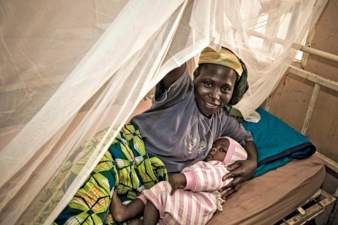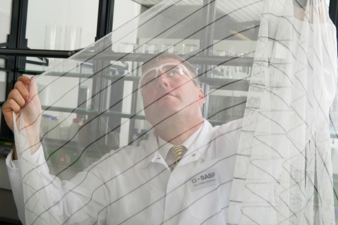18/07/2017 – BASF — auf Deutsch lesen
New Mosquito net with high protection
BASF introduces first new class of public health insecticide for malaria prevention in more than 30 years. WHO recommendation for game-changing mosquito net.

There are more than 200 million cases of malaria each year and almost half a million deaths. Infants, children under five and pregnant women are the most vulnerable groups © BASF

Interceptor G2 from BASF is the first WHO-recommended mosquito net based on non-pyrethroid chemistry to beat insecticide-resistant mosquitoes. Its distinctive black and white stripes distinguish it from currently used mosquito nets. Volker Frenz, development chemist for Interceptor G2, checks a net sample in the laboratory © BASF
BASF has received a recommendation from the World Health Organization (WHO) for Interceptor G2, a long-lasting insecticide-treated mosquito net (LN) based on chlorfenapyr. Chlorfenapyr is a completely new insecticide class for combating mosquitoes for public health. This is the first WHO recommendation for a product based on a new insecticide class in more than 30 years.
Working with the Innovative Vector Control Consortium (IVCC) and the London School of Hygiene & Tropical Medicine in a collaboration lasting over a decade, BASF’s scientists successfully repurposed chlorfenapyr to be effective on mosquito nets and meet stringent WHO performance thresholds for public health.
Able to coat polyester netting with a long-lasting formulation
Dave Malone, IVCC Technical Manager, said “The collaboration with BASF gave us access to an insecticide with a rare combination of attributes: New to public health, effective against resistant mosquitoes, and able to coat polyester netting with a long-lasting formulation.” A second chlorfenapyr product, an indoor residual spray named Sylando 240SC, is also in the final phases of WHO evaluation.
About chlorfenapyr
Chlorfenapyr was derived by isolating a toxin from the Streptomyces fumanus actinomycete bacterium. It is new to the public health market, but has been used in agriculture and urban pest control, including in homes and food handling areas, worldwide since 1995. Chlorfenapyr belongs to the pyrrole class of chemistry and has an entirely different mode of action from current WHO-approved insecticides for public health. It works by disrupting the insect’s ability to produce energy. This makes it unlikely to show cross-resistance in mosquitoes that are resistant to currently registered public health insecticides. Further information is available on publichealth.basf.com.



